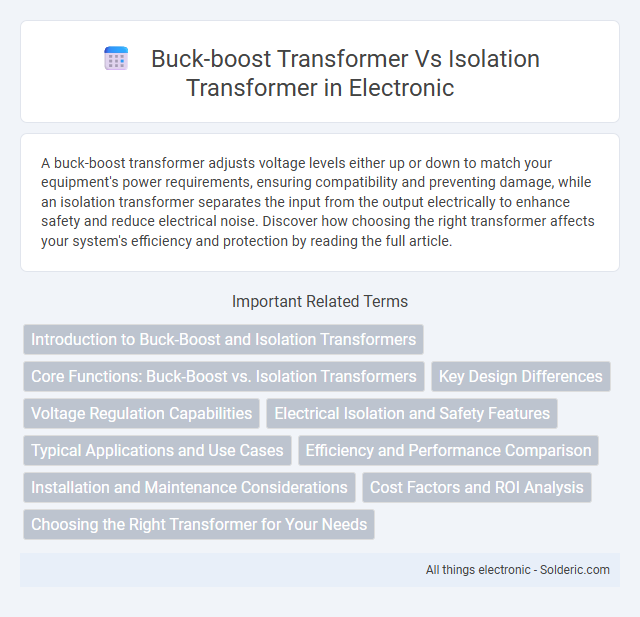A buck-boost transformer adjusts voltage levels either up or down to match your equipment's power requirements, ensuring compatibility and preventing damage, while an isolation transformer separates the input from the output electrically to enhance safety and reduce electrical noise. Discover how choosing the right transformer affects your system's efficiency and protection by reading the full article.
Comparison Table
| Feature | Buck-Boost Transformer | Isolation Transformer |
|---|---|---|
| Primary Function | Voltage adjustment (step-up or step-down by small amounts) | Provides electrical isolation between circuits |
| Voltage Regulation | Minor voltage correction, typically +-10-20% | No voltage change; maintains same voltage level |
| Isolation | No electrical isolation (primary and secondary are connected) | Complete galvanic isolation between primary and secondary |
| Typical Applications | Small voltage adjustments to compensate for supply voltage variations | Safety, noise reduction, and signal integrity in sensitive equipment |
| Construction | Shared winding with tap settings for voltage adjustment | Separate primary and secondary windings |
| Protection | Limited protection; no isolation from faults | Protects equipment and users from electrical faults |
| Cost | Generally lower cost | Typically higher cost due to isolation design |
Introduction to Buck-Boost and Isolation Transformers
Buck-boost transformers are specialized transformers designed to adjust voltage levels slightly, typically providing a small step-up or step-down to stabilize voltage within electrical systems. Isolation transformers, on the other hand, primarily serve to electrically isolate the input from the output, enhancing safety by preventing direct current flow and reducing electrical noise in sensitive equipment. While buck-boost transformers focus on voltage correction, isolation transformers prioritize signal integrity and protection against electrical faults.
Core Functions: Buck-Boost vs. Isolation Transformers
Buck-boost transformers primarily regulate voltage levels by either stepping voltage up or down to match specific equipment requirements, ensuring efficient power delivery and voltage stability. Isolation transformers, in contrast, focus on providing electrical separation between input and output circuits for safety, noise reduction, and protection against electric shock. While buck-boost transformers optimize voltage for operational consistency, isolation transformers enhance system protection and signal integrity in sensitive applications.
Key Design Differences
Buck-boost transformers are designed primarily to adjust voltage levels either slightly up or down while maintaining the same phase, making them ideal for voltage correction applications. Isolation transformers focus on separating two circuits, providing galvanic isolation to enhance safety and reduce noise without changing the voltage. Your choice depends on whether you need voltage regulation or electrical isolation, as their core designs and winding configurations reflect these distinct purposes.
Voltage Regulation Capabilities
Buck-boost transformers provide precise voltage regulation by adjusting voltage levels up or down to maintain stable output despite input fluctuations, making them ideal for fine-tuning supply voltage. Isolation transformers primarily serve to electrically separate circuits, offering limited voltage regulation capabilities but enhancing safety and reducing noise interference. The buck-boost transformer's design excels in voltage correction, whereas isolation transformers prioritize circuit protection without significant voltage adjustment.
Electrical Isolation and Safety Features
A buck-boost transformer primarily adjusts voltage levels without providing electrical isolation, making it less effective for safety-critical applications where isolation is essential. In contrast, an isolation transformer offers galvanic isolation between input and output, protecting Your equipment from electrical noise, surges, and grounding issues, thus enhancing overall safety. Electrical isolation in isolation transformers minimizes shock hazards and reduces the risk of damage to sensitive devices, which is unachievable with standard buck-boost transformers.
Typical Applications and Use Cases
Buck-boost transformers are typically used in applications requiring voltage adjustment for equipment protection and efficient motor operation in industrial and commercial settings. Isolation transformers are commonly found in sensitive electronic devices, medical equipment, and audio systems to provide electrical isolation, noise reduction, and safety enhancement. Your choice between the two depends on whether voltage regulation or electrical isolation is the primary requirement in your application.
Efficiency and Performance Comparison
Buck-boost transformers typically offer higher efficiency in voltage adjustment applications by minimizing energy loss during voltage step-up or step-down processes. Isolation transformers provide superior performance in electrical isolation and safety but may exhibit slightly lower efficiency due to added winding and core construction features that prevent direct electrical connection. Choosing between the two depends on whether voltage regulation efficiency or circuit isolation and noise reduction are the primary performance criteria.
Installation and Maintenance Considerations
Buck-boost transformers typically require simpler installation due to their smaller size and straightforward wiring, ideal for voltage correction without isolation. Isolation transformers demand more space and intricate connections, as they provide galvanic separation for enhanced safety and noise reduction. Your choice influences ongoing maintenance efforts, with buck-boost transformers needing less frequent inspection compared to isolation transformers, which require regular checks to maintain their insulation integrity and performance.
Cost Factors and ROI Analysis
Buck-boost transformers generally offer lower initial costs compared to isolation transformers due to their simpler design and smaller size, making them a cost-effective choice for voltage adjustment applications. Isolation transformers, while more expensive upfront, provide enhanced safety and noise reduction benefits, potentially reducing equipment damage and downtime, which can improve your overall return on investment (ROI) in critical systems. Evaluating total cost of ownership, including maintenance, energy efficiency, and lifespan, is essential to determine the optimal transformer type for your specific application.
Choosing the Right Transformer for Your Needs
Buck-boost transformers efficiently adjust voltage levels by providing step-up or step-down voltage conversion, ideal for applications requiring voltage correction without isolation. Isolation transformers focus on isolating the primary and secondary windings, enhancing safety and reducing electrical noise in sensitive equipment. Selecting the right transformer depends on whether voltage adjustment or electrical isolation is the primary requirement for your specific application.
buck-boost transformer vs isolation transformer Infographic

 solderic.com
solderic.com